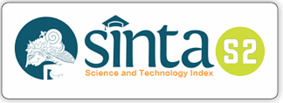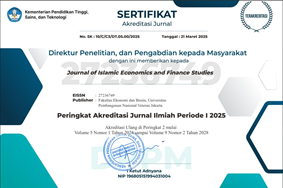Is the Volatility of the Islamic Stock Index Lower than the Conventional Stock Index during Covid-19 Pandemic? Empirical Evidence in Indonesia Stock Exchange
DOI:
https://doi.org/10.47700/jiefes.v3i1.4364Keywords:
Conventional, Islamic Stock Index, VolatilityAbstract
Abstract
The Islamic stock index is a composite index of Islamic stocks listed on the Indonesia Stock Exchange (IDX). Therefore, is expected to have low volatility and be resistant to a possible financial crisis. This study aims to see whether the volatility of the Islamic stock index is lower than the conventional stock index during the Covid-19 crisis. The data taken is daily stock closing data for JKSE and JII for the period March 1, 2020, to April 30, 2022, with a total of 532 observations. The model used is ARMA/ ARIMA which is then followed by the ARCH – GARCH volatility model. The results of this study indicate that the appropriate Islamic and conventional stock index volatility model is GARCH(1,1) and there is no problem with the asymmetry effect. The findings of this study are that during the Covid-19 crisis, there was a tendency that the return volatility of the Islamic stock index to be lower than conventional and that the Islamic and conventional stock indexes were relatively low against the financial crisis that occurred.
Abstrak
Indeks saham syariah adalah indeks komposit saham syariah yang tercatat di Bursa Efek Indonesia (BEI). Karena itu, diharapkan memiliki volatilitas rendah dan tahan terhadap krisis keuangan yang kemungkinan terjadi. Penelitian ini, bertujuan untuk melihat apakah volatilitas indeks saham syariah lebih rendah dibandingkan indeks saham konvensional semasa krisis yaitu Covid-19. Data yang diambil adalah data penutupan saham harian JII dan IHSG periode 1 Maret 2020 sampai dengan periode 30 April 2022, sebanyak 532 pengamatan. Model yang dipergunakan adalah ARMA/ ARIMA yang kemudian dilanjutkan dengan model volatilitas ARCH – GARCH. Hasil penelitian ini menunjukkan bahwa model volatilitas indeks saham syariah maupun konvensional yang sesuai adalah GARCH(1,1) dan tidak terdapat masalah effect asimetri. Temuan penelitian ini adalah selama krisis Covid-19 terdapat kecenderungan bahwa volatilitas return indeks saham syariah lebih rendah dibandingkan konvensional dan indeks saham syariah maupun konvensional relative tidak imum terhadap krisis keuangan yang terjadi.
References
Ahmad, Z., & Ibrahim, H. (2002), “A Study of Performance of The KLSE Syariah Index“. Malaysian Management Journal 6 (1 & 2): 25-34
Albaity, M. & Ahmad, R. (2008), “Performance of Syariah and composite indices: evidence from Bursa Malaysia”, Asian Academy of Management Journal of Accounting and Finance, Vol. 4 No. 1, pp. 23-43.
Aliyev, F; Ajayi, R & Gamis, N. (2020). Modelling Market Volatility with Univariate GARCH Models: Evidence from Nasdaq-100. The Journal of Economic Asymmetries 2020, 22, e00167; doi:10.1016/j.jeca.2020.e00167.
Bollerslev, T. (1986). Generalized Autoregressive Conditional Heteroskedasticity. Journal of Econometrics 31 (1986) 307-327. North-Holland
Brooks, C & Burke, SP.. (2003). Information criteria for GARCH model selection, The European. Journal of Finance, 9:6, 557-580, DOI: 10.1080/1351847021000029188
Brooks, C. (2019). Introductory Econometrics for Finance. Fourth Edition. Cambridge University Press.
Chiadmi, M. S. & Ghaiti, F. (2012), ”Modeling Volatility Stock Market using the ARCH and GARCH Models: Comparative Study between an Islamic and a Conventional Index (SP Sharia’h VS SP 500)”, International Research Journal of Finance and Economics ISSN 1450- 2887 Issue 91
Chiadmi, M. S., & Ghaiti, F. (2014). Modeling Volatility of Islamic Stock Indexes: Empirical Evidence and Comparative Analysis. IJER © Serials Publications 11(2), July-Dec. 2014: 241-276. ISSN: 0972-9380
Engle, R. F. (1986). Autoregressive Conditionsl Heteroscedasticity with Estimates of the Variance of United Kingdom Iflation. Econometrica, Vol. 50, No. 1. 1982, pp. 987 – 1007.
Hakim, M. H. (2020). Capturing the Performance of the Indonesian Sharia Stock Index (ISSI) and Composite Share Price Index (IHSG) Jakarta During Bullish and Bearish Period 2016-2019. Falah: Jurnal Ekonomi Syariah. Vol. 5 No. 2 (2020) pp. 84-98. ISSN (print): 2502-3918 | ISSN (online): 2502-7824
Hersugondo, H; Sadiyah C; Handriani, E; Subagyo, H & Astuti S. D. (2020). An Analysis of Sharia and Conventional Shares' System at Indonesia Stock Exchange. Perisai : Islamic Banking and Finance Journal. 4:1. doi: 10.21070/perisai.v4i1.228.
Huber, J., Palan, S., & Zeisberger, S. (2019). Does Investor Risk Perception Drive Asset Prices in Markets? Experimental Evidence. Journal of Banking and Finance, 108, 1–17. https://doi.org/10.1016/j.jbankfin.2019.105635
Hussein, K. & Omran, M. (2005), “Ethical Investment revisited: evidence from Dow Jones Islamic indexes”, The Journal of Investing, Vol. 14 No. 3, pp. 105-124.
Inlistya, V. A. (2017). Perbandingan Metode Antara GJR-GARCH dan EGARCH Pada Analisis Volatilitas Indeks Saham Syariah Indonesia. Departemen Matematika, Fakultas Matematika dan Ilmu Pengetahuan Alam, Institut Teknologi Sepuluh Nopember. Surabaya
Jebran, K., Chen, S., & Zubair, M. (2017). Islamic and Conventional Equity Index Co-movement and Volatility Transmission : Evidence from Pakistan. Future Business Journal, 3(2), 98–106. https://doi.org/10.1016/j.fbj.2017.05.001
Kameel, A. (2009), Solution to the Global Financial Crisis. The Edge.
Lin, Z. (2018). Modelling and Forecasting the Stock Market Volatility of SSE Composite Index using GARCH Models. Future Generation Computer Systems, 79(3), 960–972. https://doi.org/10.1016/j.future.2017.08.033
Mahapatra, S., & Bhaduri, S. (2019). Dynamics of the Impact of Currency Fluctuations on Stock Markets in India: Assessing the Pricing of Exchange Rate Risks. Borsa Istanbul Review, 19(1), 15–23. https://doi.org/10.1016/j.bir.2018.04.004
Maharani, N. K. (2017). Analisis perbandingan kinerja saham syariah antara DJIMI, FSTE GIIS, KLSESI, dan JII. Jurnal Ekonomi & Keuangan Islam, Vol. 3 No. 1, Januari 2017: 10-18
Marobhe, M & Patiry, D. (2020). Modeling Stock Market Volatility Using GARCH Models Case Study of Dar es Salaam Stock Exchange (DSE). Review of Integrative Business and Economics Research, Vol. 9, Issue 2.
Mubarak, F & Bisma, MFA. (2020). Modeling of Jakarta Islamic Index Stock Volatility Return Pattern with GARCH Model. Al-Tijary Jurnal Ekonomi dan Bisnis Islam. 2020, Vol. 6, No. 1, Hal. 17 – 30. P-ISSN: 2460-9404; E-ISSN:2460-9412. doi:http://dx.doi.org/10.21093/at.v6i1.2468
Rejeb, A. B & Arfaoui, M. (2018). Do Islamic stock indexes outperform conventional stock indexes? A state space modeling approach. European Journal of Management and Business Economics Vol. 28 No. 3, 2019 pp. 301-322. Emerald Publishing Limited 2444-8494. DOI 10.1108/EJMBE-08-2018-0088.
Ridha, R & Wibowo, A. (2020). Analisis Volatilitas Return Indeks Saham Sektor Barang Konsumsi Di Indonesia: Aplikasi Metode Threshold-GARCH (TGARCH). Variance, Journal of Statistics and Its Applications. Volume 2 Nomor 1 Juni 2020.
Robiyanto, R., Santoso, M. A., & Ernayani, R. (2019). Sharia Mutual Funds Performance in Indonesia. Business: Theory and Practice, 20, 11–18. https://doi.org/10.3846/btp.2019.02
Saiti, B., Bacha, O., & Masih, M. (2014). The Diversification Benefits from Islamic Investment During the Financial Turmoil: The Case for the US-based Equity Investors. Borsa Istanbul Review, 14(4), 196–211. https://doi.org/10.1016/j.bir.2014.08.002
Siddiqui, A.R. (2000). Dow Jones Islamic Market Index. Paper presented at Islamic Banking & Finance America 2000, 14-16 July 2000, Hilton Long Beach, CA
Tan, Z., Yan, Z., & Zhu, G. (2019). Stock Selection with Random Forest: An Exploitation of Excess Return in the Chinese Stock Market. Heliyon, 5(8), e02310. https://doi.org/10.1016/j.heliyon.2019.e02310
Tanjung, H & Siregar, T. (2018). Analisis Votalitas Saham di Jakarta Islamic Index (JII) periode Januari 2015-Januari 2018. Journal of Islamic Economics, Finance and Banking. Vol.1, No 1&2, Juni-Desember 2018, pp. 147-157, ISSN p:2622-4755, e:2622-4798
Utomo, A. S. (2022). Kinerja Saham Syariah Pada Masa Pandemi Covid 19. SEGMEN Jurnal Manajemen dan Bisnis. Volume 18 No 1 Januari 2022. p-ISSN: 0216-938X e-ISSN: 2684-8414
Wahyudi, I., & Sani, G. A. (2014). Interdependence Between Islamic Capital Market and Money Market: Evidence from Indonesia. Borsa Istanbul Review, 14(1), 32–47. https://doi.org/10.1016/j.bir.2013.11.001.
Widodo, P & Suryanto, D. (2021). Pengujian Terhadap Volatilitas Return Indeks Saham Konvensional Dengan Indeks Saham Syariah Sebelum dan Semasa Covid 19. Jurnal Sosial Humaniora Terapan Volume 4 No. 1 Juli – Desember 2021; P-ISSN 2622-1764; E-ISSN 2622-115
Yildiz, Y., Karan, M. B., & Pirgaip, B. (2017). Market Reaction to Grouping Equities in Stock Markets: An Empirical Analysis on Borsa Istanbul. Borsa Istanbul Review, 17(4), 216–227. https://doi.org/10.1016/j.bir.2017.08.001
Downloads
Published
Issue
Section
License
Authors who publish with this journal agree to the following terms:
- Authors retain copyright and grant the journal right of first publication with the work simultaneously licensed under a Creative Commons Attribution 4.0 International License that allows others to share the work with an acknowledgment of the work's authorship and initial publication in this journal.
- Authors can enter into separate, additional contractual arrangements for the non-exclusive distribution of the journal's published version of the work (e.g., post it to an institutional repository or publish it in a book), with an acknowledgment of its initial publication in this journal.
- Authors are permitted and encouraged to post their work online (e.g., in institutional repositories or on their website) before and during the submission process, as it can lead to productive exchanges, as well as earlier and greater citation of published work.

This work is licensed under a Creative Commons Attribution 4.0 International License.











